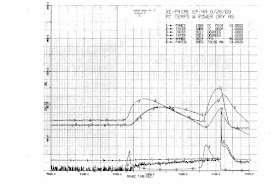from xkcd, Gravity wells
Of great importance and a subject I never see really mentioned anywhere: after six months in space, humans are really incapable of doing anything under gravity for a little while. It's one thing to land on Mars, it will be another before they can leave their seats. For that reason only and if one is serious about landing people on Mars and unless we find a pill to get space travelers to not deteriorate too much, getting there faster is really the only way. Hence the nuclear rocket option.
- The Soviets flew in low Earth Orbit more than 30 Rorsats that had nuclear reactors in them, The underlying reason for the need for much power was the relative unsophistication of the signal processing that could be done on-board. With no compression, one had to resort to larger power levels to send out all those signals. At the end of the cold war, the US sought to buy a different and advanced technology from the Russians (TOPAZ).
- There are simpler systems however. Most of the probes beyond Low Earth Orbit require power levels that cannot be provided by the Sun. Currently the rather large Curiosity rover is getting its energy from the decay of Plutonium-238 that heats up elements and produce electricity through the reverse of the Peltier effect.
from [1]
"...Then, after the Kiwi TNT safety reactor test was conducted (to learn how destructive the reactor assembly would be if its control rods went wildly out of control) and the reactor assembly was self-destructed, the Los Alamos NRDS Assistant Director, two of his associates, and again Rocketdyne's NTR Section Chief were exposed to the after-test radiation surrounding the destroyed reactor assembly. The measured environment radiation was approximately 10 rem. Fifty years have passed, and the health of the above-defined test programs participants (as determined by the NTS Medical Surveillance Project Office's evaluation) remain unaffected by radiation...."
Some videos of the tests can be found on Youtube:
h/t Various Consequences
[1] XE-prime EP-4A startup tests. SPEAR report


Hi Igor
ReplyDeleteNice article. And great graphics you gathered.
I am all for reducing travel time.
There has been a lot of promising research on ways to keep bone density from decaying (e.g. http://science.nasa.gov/science-news/science-at-nasa/2001/ast02nov_1/) but it seems to me they hardly progressed from testing in a decade
http://www.homebaseddally.com/good-vibrations-for-stronger-bones-and-pain-relief/
The moon provides a platform where dust-free solar arrays of huge size may be constructed from lunar materials and used to easily propel objects off the moon with low-g rail guns, to assemble vehicles and ahbitats for Mars missions. The arrays themselves can orbit the moon to avoid being in the dark for two weeks.
ReplyDeleteOn Mars, if it was me spending years there I would want technology I could build or repair on Mars, not something I had to wait a couple years to be fixed. Again large stationary or orbiting solar arrays with protection from storms and sufficient storage would be a happier lower tech solution for self-reliant space colonies. A strike by an object could wreck a nuclear power plant.
As for propulsion to and from Mars, ion propulsion with acceleration and deceleration from orbiting solar arrays is the lowest-risk and fastest way to make the trip. Hohmann transfer orbits are not really useful unless you are using rocket propulsion from the last century. With ion propulsion it might make sense to fly closer to the sun.
Mycarta,
ReplyDeleteI agree the science to help in reducing bone issues is still not there yet. It is also difficult to make any real progress if you have a few people in orbit.
Dennis,
I understand there are other scenarios but they really require much more engineering that is not at the level of readiness that NERVA attained. Furthermore none of what you propose address the issue of speed to Mars. Ion propulsion is a much more efficient system (ISP close to 10000) than NERVA but does not have its thrust capabilities. In order to have these thrust levels (and high speed to Mars), one would probably require a nuclear reactor (VASMR...). I understand the fear factor, but I would argue that the large projects you are mentioning are potentially much less safe. Then again it is just my opinion and I am known to change it with supporting experimental data.
Igor.
Igor said: The Achille's heel of these system is their scrubbing mechanism i.e. make sure none of the reactor core material is stripped from its location and sent outside through the nozzle system.
ReplyDeleteDo you know of any indirect cycles that don't expose the working fluid to the nuclear fuel? The closest thing I know of is the indirect cycle from the nuclear aircraft program.
Maybe it's just too hard to get the heat transfer rates needed for a rocket without putting the reaction mass in contact with the fuel.
Hi,
ReplyDeleteFirst, the nuclear fuel is not exposed to the coolant. There is cladding involved. But to answer the theme of your question, the only system that is higher in the technology readiness level than 1 (paper study) is VASIMR http://en.wikipedia.org/wiki/Variable_Specific_Impulse_Magnetoplasma_Rocket although I am not sure of how high the thrust of the system is.
Igor.